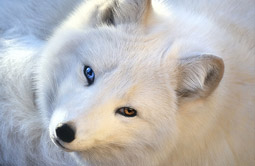Rarely quick and painless
Those fur animals whose necks are broken when a trap snaps shut are lucky. On fur farms, most animals suffer neither a quick nor a painless death. Depending on the method used, it will take the animal a long time to die.
Suffocating
If fur animals such as nutrias or muskrats are trapped in underwater traps, the animals often fight for their lives for up to 20 minutes before they drown or suffocate.
Neck breaking
If the necks of minks or chinchillas are broken properly and rapidly, the animals will not suffer very much. They are numbed by a hit or an electric shock and then positioned on the edge of a board. Their heads are bent backwards and then pulled forward suddenly in order to break their backbones and clip the nerve tracts between their heads and their bodies.
Battering
Seal babies on Arctic drift ice are battered with clubs, often only numbed and then skinned while still alive. On fur farms, the animals are hit frontally on their skulls so that their meat may still be used for feeding purposes. An imprecise hit will make the animal suffer tremendously and die a slow death.
Shooting
Seals are often hunted with rifles. Many are only hit, flee and then perish painfully from their wounds. Bolt guns are also often used on fur farms. Their effect is similar to being beaten with clubs.
Electrocution
Foxes are often electrocuted. To this effect, an electrode is introduced into the animal’s anus and another into the animal’s mouth. The electric shock usually kills the animal immediately but the foxes are submitted to tremendous stress and fear when they are chased, caught and prepared for electrocution. Often enough, car batteries are used - and used over longer periods of time, so that the electric apparatus does not kill the animal at the first attempt.
Gasification
Most minks are gassed with carbon dioxide (CO2) or carbon monoxide (CO). Highly concentrated CO2 numbs the animals rapidly (death only occurs at a later point in time), but leads to suffering in form of sharp pain in the respiratory system. Because minks are able to dive, they attempt to hold their breath and to keep their heads above the gas. The CO2 is usually conducted into closed boxes via the exhaust of a tractor motor. After approx. 40 seconds of fighting unsuccessfully, the minks will lose consciousness. If the gas is not cooled and filtered, however, this will lead to major suffering.
Poisoning
Various deadly injections are used to put fur animals down. Some injections kill animals painlessly; whereas others only take effect after several minutes. During this time, the animals suffer unspeakably. Injection pistols are often used for mass killings.

